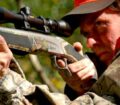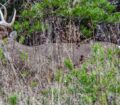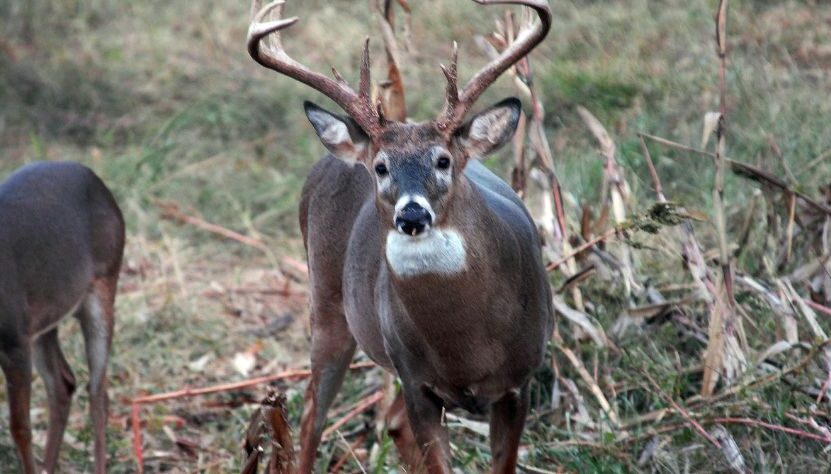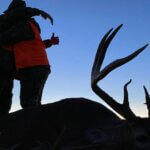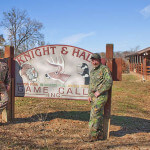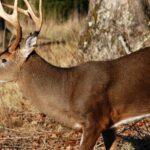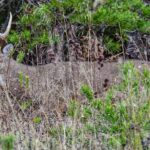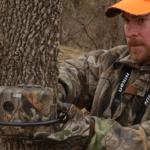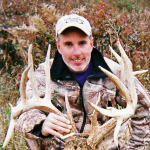Editor’s Note: Understanding how Tim Davis of Georgia manages his land can help you learn to manage your small property to produce big bucks. Davis has proven that to produce and take trophy bucks on your property, the amount of land you have to hunt isn’t as important as how you hunt and manage your land. On only 7 acres of land, Davis has harvested trophy bucks.
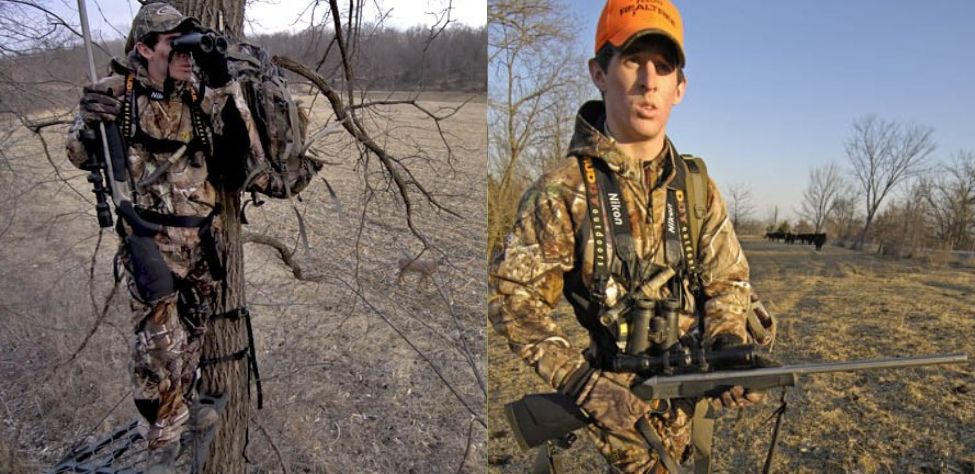
I built my home on 7 acres of property, and then the next year, I planted two food plots with Durango clover. Although my property is primarily hardwoods and provides plenty of acorns for deer, I thought the food plots would be an extra attractant to whitetails. Since I could see one of the food plots from the little workshop behind my house, I knew both food plots were pulling in. Knowing that it attracted bucks during the rut, I decided to wait to see what happened.
On my small 7 acres, I’ve been able to take a trophy buck about every 2 years for some time. Usually, I can spot the buck I want to take when he’s young, watch him grow up, and then take him when he’s in his prime. At least, that’s the way it’s supposed to work. But there was one monster buck I never was able to take. I only got one picture of him on a trail camera in August one year at 3:00 am. I didn’t know his size, but I knew he was large and would score more than 170 points on Boone & Crockett.
One of my advantages is that the old cow pasture planted in pines that the deer use for a bedding area isn’t hunted. However, I have the landowner’s permission to cross his fence and recover any deer I shoot on my property. This bedding area is about 80 acres and provides a sanctuary for deer. With my green fields and hardwood trees producing acorns, I’m the first good food source next to this bedding area. Often I’ll spot nice bucks in this area and have taken some of them. Or, once I see them, I may wait and let those bucks grow before taking them another year.
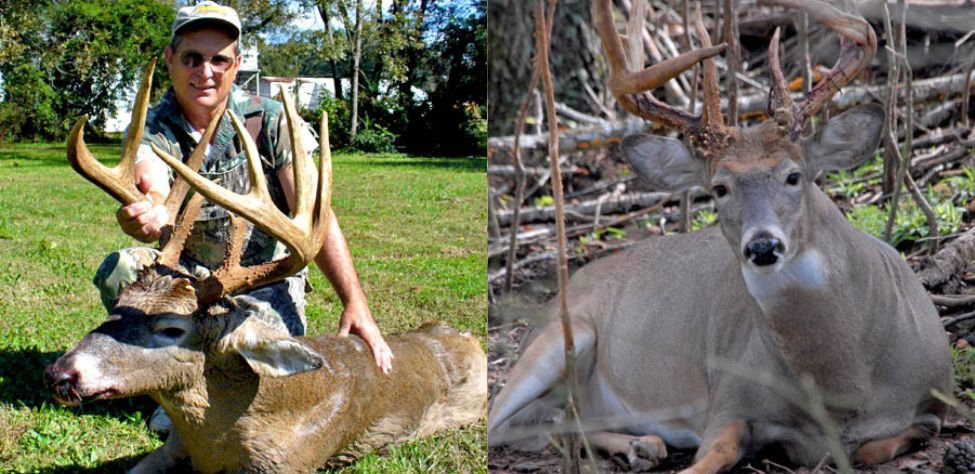
Factors you need to consider when hunting small sections of land:
- You can consistently take big bucks off little plots of land if you know the history, the hunting pressure, and the deer’s needs.
- You drastically can increase your odds of taking trophy bucks, if you can locate a thick-cover bedding area that’s a sanctuary and plant a green field or have an agricultural crop right next to that bedding place.
- A number of big bucks live close to or in suburbia because those regions provide sanctuary for the deer.
- You may be more successful by managing the land you have to hunt to produce trophy bucks rather than having a large amount of land to hunt. As good hunting land becomes harder to find, we all must consider managing deer more intensively on less acreage and providing more sanctuaries.

How to Hunt and Take Big Buck Deer on Small Properties
In this book, you’ll hear from 14 hunters who either have gained permission or leased properties as small as six acres to as much as 250 acres, and how they consistently take older-age-class bucks off these little lands.
VERSIONS: AUDIBLE, KINDLE & PRINT

Jim Crumley’s Secrets of Bowhunting Deer
Using a black magic marker and a gray work jumpsuit, Jim Crumley of Buchanan, Virginia, drastically changed the nature and purpose of hunting camouflage when he created the first sportsman’s camouflage – Trebark. Crumley’s love of bowhunting and his desire to be more invisible changed hunting clothing forever.
In this hunting guide, he shares the wisdom that he’s learned throughout his lifetime about how to be a hunter, how to find a deer lease, how to scout for deer, and more.
Special features include how to:
- Have a magic 60 acres to hunt
- Decide the best equipment to use
- Find deer year-round
- Locate land to hunt
- Know the best place to put your tree stand
- Get bucks within bow range
VERSIONS: AUDIBLE, KINDLE & PRINT

How to Hunt Deer Like a Pro
How do you know if the land you hunt has a trophy deer on it? Wildlife manager Bob Zaiglin, of Uvalde, Texas and Jim Crumley, the father of modern-day hunting camouflage, tells you how to find out. GPS can make finding and taking that trophy buck easier. This hunting guide will teach you how to hunt big bucks where no one else can find them, how to call deer, and how to become versatile as a deer hunter, so that if one deer tactic doesn’t work, another one will.
In the chapter, “How to find Bucks at Scrape,” Dr. Keith Causey, retired professor of Wildlife Science at Auburn University, describes the best way to hunt a scrape.
Brad Harrison of Neosho, Missouri, is a nationally-known videographer, professional deer hunter and master at calling deer. Another master is Will Primos of Primos Game Calls. These two experts will tell the best deer calls and when to use them in this book.
And for over 20 years, Bo Pitman, lodge manager of White Oak Plantation, has been studying deer movement patterns. He explains what types of conditions are best for predicting deer movement.
VERSIONS: AUDIBLE, KINDLE & PRINT

Deer hunting and deer hunters are drastically changing each year. To learn new techniques for hunting deer and have more places to hunt, I’ve interviewed some of the best deer hunters in the nation and share their tactics in How to Hunt Deer Like a Pro: Volume II.
In Chapter 10, Jacob Lamar tells you his tactics for consistently taking older-age-class bucks on public lands in several states. Chapter 11, Bob Walker explains how to find places on public lands where you can hunt that 99 percent of the other hunters never have considered hunting. The Bonus Chapter with David Ramey tells you how, where, when and with what equipment to take big Kansas bucks on public lands by hunting in 100-degree weather when others won’t hunt.
Chapter 13, Mark Drury, his family and his guests take mature bucks every season by having more small places to hunt rather than one large property. Drury explains the strategy of having satellite farms to hunt that only may be 50-150 acres each or less. Chapter 15, Pat Reeve, who hunts far-northern states and Canada, says, “I don’t like hunting for mature bucks until the weather is 20 degrees or less.” Chapter 4, Dr. Larry Marchinton says that funnels are the most-reliable stand sites to hunt for big bucks and tells why.
VERSIONS: AUDIBLE & PRINT
Tomorrow: How Northern Hunters Man-Drive for Deer

